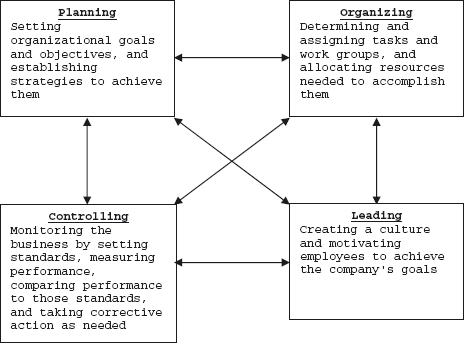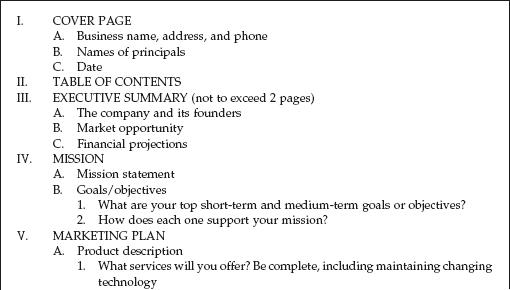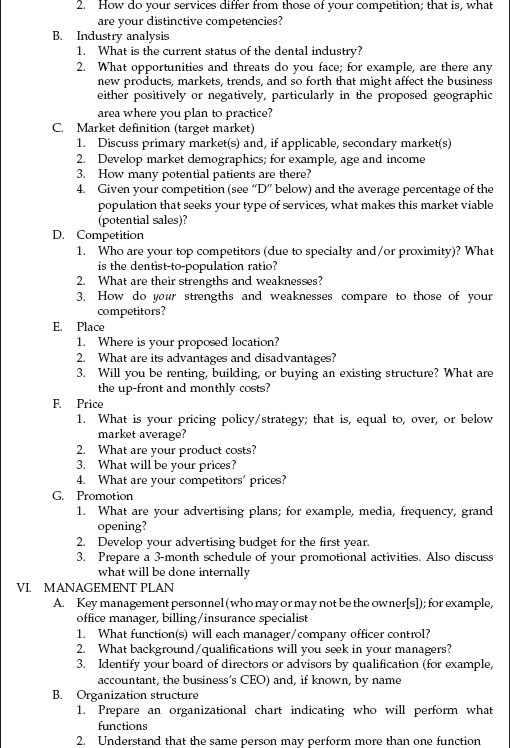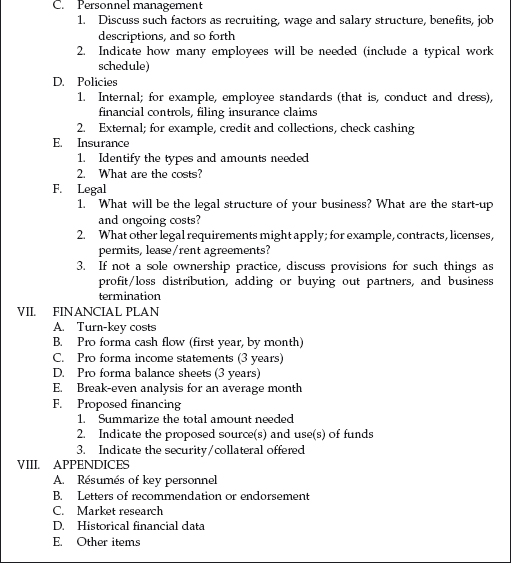Chapter 2
Business Plans in Dentistry
Failure to plan is planning to fail.
When you have your own dental practice, you will not only be a practicing dentist but also a small business owner. As such, you will be responsible for managing all aspects of your practice, which requires much time, study, and effort. One key to your success as a business manager is to continually think about the future and not rely on good things to just happen. What do you want to do? When do you want to do it? How will you accomplish it? Success, then, is rooted in having a plan for its achievement.
After completing this chapter, you will understand:
Management and the Management Process
Management is the effective and efficient planning, organizing, leading, and controlling of limited resources in the face of a changing environment to achieve organizational goals.
This definition reflects four important concepts: (1) the effective and efficient accomplishment of goals; (2) the limitation of resources; (3) the constantly changing environment, both internal and external to the organization itself; and (4) the four basic management functions of planning, organizing, leading, and controlling.
Being effective means getting the job done—achieving your stated goal. Being efficient means using the fewest resources to accomplish that goal. For example, explaining a new procedure to each dental assistant one-on-one would be highly effective because you could ensure that each one fully understands it. However, it would not be very efficient because of the total amount of time you would spend. In contrast, you could be very efficient and explain the new procedure in a group setting, but that might not be as effective as one-on-one because some people may be reluctant to ask for clarification. Your job as a manager is to balance the two without having a negative impact on your operations. The second concept, limited resources, recognizes that there is a finite amount of all resources. There are, for example, only 24 hours in a day, a finite number of dental chairs in your office, and only one of you. A constantly changing environment is a reality of life, both outside and inside your practice. The question is not whether things will change, but at what rate they will change. Externally, new dental procedures and technologies are discovered virtually every day. The economy can impact decisions to purchase new technologies or to move to a new location. Internally, hiring new employees brings new skills and new personalities to your staff. Your decision to implement a new administrative (office) procedure can be seen as positive or negative by different employees. Figure 2.1 illustrates how the four basic management functions of planning, organizing, leading, and controlling interact as a process.
Clearly, the management process must begin with planning. Without a goal, it is impossible to determine how to organize your practice, how to lead your team, or how to control your efforts. After establishing your goals and creating a plan to achieve them, you must organize your practice and hire the right people so as to achieve those goals. You and your management team must then lead your staff by creating a positive, shared culture and motivating each person to achieve individual and practice goals. Finally, you must monitor employees’ progress to ensure the effective and efficient accomplishment of goals, taking corrective action as necessary. In other words, the goals you established in the planning process become the standards against which you compare employee performance in the control process. If all is going well, your job is to encourage continued good performance. However, if goals are not being met, you must take corrective action. You must evaluate both the goal in question and the employees’ performance. Your evaluation might determine that the goal is still valid and employee behavior must be corrected. However, you may determine that the stated goal is no longer valid due to a changing environment. For example, after you wrote your goals, you purchased new technology, or you hired new employees with different individual needs, or your patient load increased or decreased. As a result, you need to raise or lower the bar—that is, change the goal. So, even though everything begins with planning, all four management functions are interrelated and are ongoing, and any one can have an impact on any other one. Hence, it is called the “management process.”
Figure 2.1. The management process.

Why Is Planning Important?
Overall, the primary purpose of planning is to offset future uncertainty by reducing the risk of an event catching you completely off guard. More specifically, planning
Attracts potential lenders
Aids in attracting customers and employees
Helps enterprises succeed (but no guarantees)
Provides direction
Helps management cope with change
Contributes to the performance of the other management functions
Helps to evaluate your progress (the planning function becomes an integral part of the control function by acting as standards of performance)
Why Do Managers Not Plan?
Good planning is hard work.
Planning is long term, and we tend to be short-term oriented.
Planning is only one activity of many, and we are often too busy “putting out fires.” Note the irony—perhaps better planning would prevent those fires from ever occurring.
You could be called to task if the plan does not work out, and failure is a concept we do not embrace.
What Is a Business Plan?
A business plan is a written document that describes and analyzes a proposed or current business and includes a marketing plan, a management plan, and a financial plan. While there are no guarantees of success, a well-written plan offers business owners a greater probability of success simply because it requires them to think about virtually every aspect of their business. A business plan is a roadmap for your dental practice. On the other hand, having a business plan, even one that is highly detailed, does not guarantee success. As that anonymous someone once said, “Poor management can cause even a McDonald’s to fail.”
Why Write One?
The main purpose for writing a business plan should be to allow the entrepreneur the opportunity to gain an in-depth look at the potential for the business’s success and what it will take to achieve that success. In other words, your primary audience should be yourself. However, many entrepreneurs write their business plan solely to obtain financing. Well-written business plans can help you answer many questions, including:
- What specific products (goods and/or services) do you offer?
- Is your target market large enough for the practice to be profitable, given the competition?
- How many support personnel will you need, and at what cost?
- Are the professional and support staff that are in the available labor pool qualified at the service level you desire/require?
- What level of revenues is required for you to break even in an average month?
In other words, given your proposed location and the services you plan to offer, a business plan can help you determine whether or not your practice has the potential to be successful. By putting together a thorough plan, you may discover that a change or changes might be warranted; for example, choosing a different location, offering different hours of operation, or partnering with another dentist or dentists (a second or third dentist in the same location only marginally increases the overhead costs).
How Long Should the Plan Be?
The short answer is, as long as it needs to be. The main body of most plans should be no more than 25 to 30 pages. Generally speaking, the higher the amount of financing you require, the more detailed the plan should be in order to justify the desired financing and to substantiate your ability to repay the lender/investor.
This is not a document you can expect to write over a free weekend while having a few glasses of wine (with cheese and crackers, of course). Nor should you expect the first draft to be the final draft. As with any important paper, you should do your research (using your business plan outline as a guideline) and then put together the first draft. Put it down for a day or two, and then read it as if you were the investor, making notes of possible changes. Then, rewrite it and put it down for a day or two before re-reading it. Go through this process until you are satisfied it is complete—that it tells the whole story. Then, go back and make sure it is grammatically correct, especially your cover letter. Remember, people often write like they speak, but the rules for speaking are different than for writing. You do not want to lose a potential investor because of errors in your plan. That shows a lack of attention to detail that will not bode well for you as a manager (and a seeker of funding).
Another important point is to make sure that the end results—the numbers in your financial projections—are a result of your research, and not the other way around—that is, the “research” was developed to support the numbers that reflect a positive outcome. Making the numbers show a great cash flow and a large profit will often lead to difficulties later on. You might even be able to convince the banker that your plan is accurate, but you know the real story.
Business Plan Format
While every business plan is unique and should be designed and written for a specific purpose, certain elements are universal. Figure 2.2 provides one such framework and is the basis for this discussion. The sample business plan at the end of the chapter illustrates another format. Some of the topics in Figure 2.2 are not included, and some are not in the same sequence, location, or detail. Again, your business plan should be written to meet your needs. There is no “perfect” business plan format. The outline discussed here and the sample business plan appearing later in this chapter demonstrate this fact.
Figure 2.2. Business plan format.



Elements of the Plan
Cover Page
The cover page identifies the name, address, and phone number of the business and the owner(s), as well as the date the plan was submitted. If you are requesting funds from more than one source, also include a copy number.
Table of Contents
The table of contents provides a concise overview of the plan’s contents and should list, as a minimum, each primary and secondary heading with its starting page number. For example, a major heading would be “Mission,” and a secondary heading would be “Mission Statement.”
Executive Summary
This introduction to your proposal must capture the attention of the reader with a convincing message to read the entire plan. It is a brief synopsis (not more than 2 pages) that addresses the essence of your proposed business. Hence, even though it is the first thing read, it is the last thing written. While a lender might talk about having read, say, five hundred business plans, what the lender really read were five hundred executive summaries. Only a small percentage of those executive summaries successfully led to the full plan being read, so these introductory comments are critical and foundational.
Imagine that just you and a potential investor are in an elevator, and you have that person’s undivided attention for maybe 1 minute. What would you say to convince this person that your proposal would be a great investment opportunity? The executive summary is simply a written version of an “elevator pitch” and should briefly describe the following:
- The company and its founders: describe your service, what is special about it, and what the qualifications of the owner(s) are.
- The market opportunity: describe the size and growth rate of your market and how it is currently being served.
- The key financial highlights. Summarize your sales and profit projections for at least the first year. Clearly state the total capital needed from all sources (including personal resources), what use will be made of each source’s capital, and an anticipated repayment schedule. While you may not know the exact terms of the loan (such as the interest rate and length of the loan), you should make a reasonable estimate. For example, suggesting that a loan of $5,000 can be obtained at a 2% interest rate to be repaid over 5 years would not be reasonable. Lastly, include when your business practice will financially break even.
Mission
Mission Statement
A company’s mission statement answers the question, why do I exist? It is a short statement (25 words or less) that tells employees, clients, and investors what you do and what you believe in. In other words, it gives direction to your practice. It is like your elevator pitch—you need to be able to summarize your proposal in about 1 minute. If you cannot summarize the essence of your business and what you stand for in no more than about 25 words, you probably do not have a handle on who you are and what you are all about.
Goals and Objectives
While the mission />
Stay updated, free dental videos. Join our Telegram channel

VIDEdental - Online dental courses


